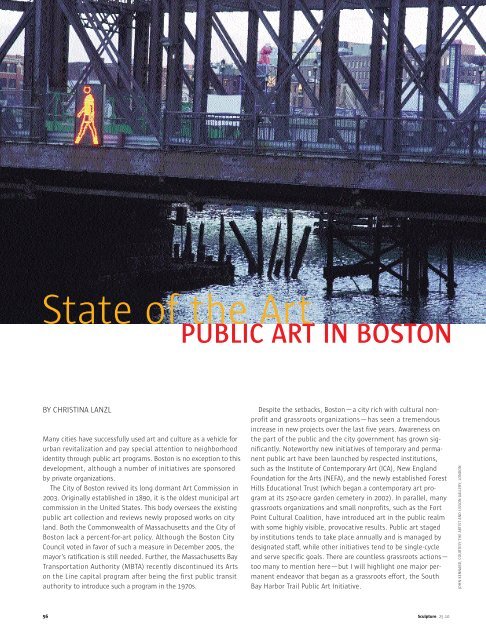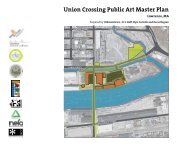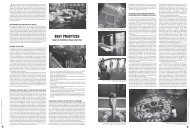State of the Art - Massachusetts College of Art
State of the Art - Massachusetts College of Art
State of the Art - Massachusetts College of Art
You also want an ePaper? Increase the reach of your titles
YUMPU automatically turns print PDFs into web optimized ePapers that Google loves.
<strong>State</strong> <strong>of</strong> <strong>the</strong> <strong>Art</strong><br />
PUBLIC ART IN BOSTON<br />
BY CHRISTINA LANZL<br />
Many cities have successfully used art and culture as a vehicle for<br />
urban revitalization and pay special attention to neighborhood<br />
identity through public art programs. Boston is no exception to this<br />
development, although a number <strong>of</strong> initiatives are sponsored<br />
by private organizations.<br />
The City <strong>of</strong> Boston revived its long dormant <strong>Art</strong> Commission in<br />
2003. Originally established in 1890, it is <strong>the</strong> oldest municipal art<br />
commission in <strong>the</strong> United <strong>State</strong>s. This body oversees <strong>the</strong> existing<br />
public art collection and reviews newly proposed works on city<br />
land. Both <strong>the</strong> Commonwealth <strong>of</strong> <strong>Massachusetts</strong> and <strong>the</strong> City <strong>of</strong><br />
Boston lack a percent-for-art policy. Although <strong>the</strong> Boston City<br />
Council voted in favor <strong>of</strong> such a measure in December 2005, <strong>the</strong><br />
mayor’s ratification is still needed. Fur<strong>the</strong>r, <strong>the</strong> <strong>Massachusetts</strong> Bay<br />
Transportation Authority (MBTA) recently discontinued its <strong>Art</strong>s<br />
on <strong>the</strong> Line capital program after being <strong>the</strong> first public transit<br />
authority to introduce such a program in <strong>the</strong> 1970s.<br />
Despite <strong>the</strong> setbacks, Boston—a city rich with cultural nonpr<strong>of</strong>it<br />
and grassroots organizations—has seen a tremendous<br />
increase in new projects over <strong>the</strong> last five years. Awareness on<br />
<strong>the</strong> part <strong>of</strong> <strong>the</strong> public and <strong>the</strong> city government has grown significantly.<br />
Noteworthy new initiatives <strong>of</strong> temporary and permanent<br />
public art have been launched by respected institutions,<br />
such as <strong>the</strong> Institute <strong>of</strong> Contemporary <strong>Art</strong> (ICA), New England<br />
Foundation for <strong>the</strong> <strong>Art</strong>s (NEFA), and <strong>the</strong> newly established Forest<br />
Hills Educational Trust (which began a contemporary art program<br />
at its 250-acre garden cemetery in 2002). In parallel, many<br />
grassroots organizations and small nonpr<strong>of</strong>its, such as <strong>the</strong> Fort<br />
Point Cultural Coalition, have introduced art in <strong>the</strong> public realm<br />
with some highly visible, provocative results. Public art staged<br />
by institutions tends to take place annually and is managed by<br />
designated staff, while o<strong>the</strong>r initiatives tend to be single-cycle<br />
and serve specific goals. There are countless grassroots actions—<br />
too many to mention here—but I will highlight one major permanent<br />
endeavor that began as a grassroots effort, <strong>the</strong> South<br />
Bay Harbor Trail Public <strong>Art</strong> Initiative.<br />
56 Sculpture 25.10<br />
JOHN KENNARD, COURTESY THE ARTIST AND LISSON GALLERY, LONDON
JOHN KENNARD<br />
Opposite: Julian Opie, Julian walking, 2005. Installation on <strong>the</strong> Nor<strong>the</strong>rn<br />
Avenue Bridge, sponsored by <strong>the</strong> ICA/Vita Brevis Project. This page: Jerry<br />
Beck, The Secret Ark <strong>of</strong> Icon Park, 2005. Interior and exterior views <strong>of</strong> mixedmedia<br />
work, sponsored by <strong>the</strong> ICA <strong>Art</strong>ists-in-Residence program.<br />
There is a shared understanding that public art is a powerful<br />
tool to bring communities toge<strong>the</strong>r and to improve our neighborhoods<br />
and public spaces. Public art <strong>of</strong>fers community-building and<br />
civic opportunities for collaboration and participation. Though various<br />
programs have different roots, agendas, and objectives, both<br />
temporary and permanent public art share <strong>the</strong> same principles.<br />
They foster dialogue, create awareness, and stimulate new expressions<br />
<strong>of</strong> contemporary art.<br />
Annually since 1998, Boston’s Institute <strong>of</strong> Contemporary <strong>Art</strong> (ICA)<br />
has sponsored Vita Brevis and ICA <strong>Art</strong>ists-in-Residence, two temporary<br />
public art programs. ICA director Jill Medvedow conceived Vita<br />
Brevis after seeing public art installations organized by <strong>Art</strong> Angel in<br />
London and at Boston’s Isabella Stewart Gardner Museum. Vita<br />
Brevis commissions local, national, and international artists to create<br />
new, temporary works for public settings that “encourage people<br />
to experience Boston’s environs and history with renewed<br />
meaning and focus.”<br />
The 8th Annual Vita Brevis installation featured Julian Opie’s<br />
Suzanne walking and Julian walking, two life-size, full-length animated<br />
figures on LED screens on <strong>the</strong> Nor<strong>the</strong>rn Avenue pedestrian<br />
bridge. Opie’s choice <strong>of</strong> site was significant because it demonstrated<br />
how a previously unknown, even endangered site can<br />
be transformed from a place <strong>of</strong> blight into a place <strong>of</strong> delight.<br />
Embattled for several years, <strong>the</strong> Nor<strong>the</strong>rn Avenue Bridge is <strong>the</strong><br />
only swing-bridge remaining from Boston’s heyday as a port city.<br />
Successful lobbying by Boston artists, architects, and preservationists<br />
from neighboring Fort Point saved it from demolition. Ongoing<br />
maintenance <strong>of</strong> both temporary and permanent public art is key<br />
to <strong>the</strong> success <strong>of</strong> any project: <strong>the</strong> ICA deserves kudos for promptly<br />
repairing Opie’s piece after it suffered damage during a storm.<br />
Since <strong>the</strong> new ICA building is on <strong>the</strong> Boston waterfront, it is<br />
only suitable that <strong>the</strong> next Vita Brevis projects are scheduled for<br />
<strong>the</strong> Boston Harbor Islands in <strong>the</strong> summer <strong>of</strong> 2007. <strong>Art</strong> on <strong>the</strong><br />
Harbor Islands is commissioning four projects by Ernesto Pujol, Teri<br />
Rueb, Anna Schuleit, and <strong>the</strong> principals <strong>of</strong> Office dA—Monica<br />
Ponce de Leon and Nader Tehrani.<br />
Based on <strong>the</strong> success <strong>of</strong> Vita Brevis and as a counterpoint to<br />
bringing national artists to Boston, in 2000 <strong>the</strong> ICA launched<br />
<strong>Art</strong>ists-in-Residence, which matches local artists with local historic<br />
sites. A partnership between <strong>the</strong> ICA and <strong>the</strong> National Park Service,<br />
this program provides a contemporary interpretation <strong>of</strong> cultural<br />
resources and historical <strong>the</strong>mes. Jerry Beck, artist, founder, and<br />
director <strong>of</strong> <strong>the</strong> Revolving Museum and long-time art maven with<br />
roots in <strong>the</strong> Fort Point arts community, was at <strong>the</strong> Charlestown<br />
Navy Yard in summer 2005 where he built his large-scale ark installation,<br />
critical <strong>of</strong> <strong>the</strong> war in Iraq and situated near historic ships<br />
like <strong>the</strong> USS Constitution. Beck’s large-scale interactive environment<br />
contrasted with Niho Kozuru’s more intimately scaled cast<br />
rubber architectural elements at <strong>the</strong> Paul Revere House, which<br />
were exhibited <strong>the</strong> year before. These enlargements <strong>of</strong> historic<br />
ornament drew attention to infinitely small things and <strong>the</strong> fine<br />
craftsmanship <strong>of</strong> times past.<br />
Ano<strong>the</strong>r partnership program introduced just three years ago by<br />
<strong>the</strong> New England Foundation for <strong>the</strong> <strong>Art</strong>s (NEFA) puts environmental<br />
awareness at <strong>the</strong> top <strong>of</strong> its agenda. <strong>Art</strong> and Community Landscapes<br />
(ACL) addresses local and regional environmental concerns<br />
by funding site-specific art projects and artist residencies. NEFA’s<br />
latest initiative is an award-winning, joint project with <strong>the</strong> National<br />
Endowment for <strong>the</strong> <strong>Art</strong>s and <strong>the</strong> National Park Service. NEFA solicits<br />
proposals for sites from organizations and <strong>the</strong>n invites artists to<br />
develop concepts for <strong>the</strong> chosen sites. The artist and partner organization<br />
work as a team to implement a community-based public<br />
art project. ACL’s emphasis on inter-disciplinary approaches and<br />
innovative partnership models is noteworthy, as demonstrated in<br />
<strong>the</strong> Chelsea Riverway project by Mark Dannenhauer in collaboration<br />
with East Boston’s Chelsea Creek Restoration Partnership<br />
(CCRP). CCRP strives to reclaim <strong>the</strong> neglected, contaminated<br />
Chelsea Creek as an environmental, recreational, economic, and<br />
educational asset for East Boston, Chelsea, Revere, and <strong>the</strong> region.<br />
Dannenhauer’s project supported that effort by allowing community<br />
members to “re-story” <strong>the</strong> polluted, neglected waterway. The<br />
parade <strong>of</strong> monumental puppets that documented Chelsea Creek’s<br />
history, ecology, people, and places continues to linger in hearts<br />
and minds, serving as a powerful advocacy and educational tool.<br />
Newly commissioned ACL works are currently being created for<br />
two sites. <strong>Art</strong>ist team Legge Lewis Legge from Austin, Texas, and<br />
Sculpture December 2006 57
Top: Niho Kozuro, Longfellow Balustrade Column, 2004. Cast rubber, work<br />
included in “Re-Turning <strong>the</strong> Past,” sponsored by <strong>the</strong> ICA <strong>Art</strong>ists-in Residence<br />
program. Bottom: Nora Valdez at work on a sculpture for <strong>the</strong> Day and<br />
Evening Academy.<br />
New York City is designing pathways, earthworks, and ornate Corten<br />
steel sculptures that loosely recall urban street furniture for<br />
<strong>the</strong> Lincoln Street Greenstrip in <strong>the</strong> Brighton neighborhood. Across<br />
<strong>the</strong> city in Roxbury, sculptor Nora Valdez is working with students<br />
<strong>of</strong> <strong>the</strong> Day and Evening Academy, an alternative public high school.<br />
As part <strong>of</strong> an innovative apprenticeship project, students are<br />
assisting <strong>the</strong> artist to carve three limestone figures and benches<br />
for <strong>the</strong> new stone garden in front <strong>of</strong> <strong>the</strong> school.<br />
Similar environmental and urban planning concerns have been<br />
core interests <strong>of</strong> Reclamation <strong>Art</strong>ists, a loosely connected group <strong>of</strong><br />
Boston-area artists and architects active since 1980. Over <strong>the</strong> years,<br />
<strong>the</strong> group’s artists have created major installations at neglected<br />
urban sites, many <strong>of</strong> which have since experienced revivals. The<br />
mission is to “call attention to <strong>the</strong> urban landscape and question<br />
how we shape, inhabit, neglect, or enhance it.” Reclamation <strong>Art</strong>ists<br />
is an elusive group that <strong>of</strong>ten works guerrilla-style, quietly scoping<br />
out neglected spaces and seemingly appearing out <strong>of</strong> nowhere<br />
with temporary, <strong>of</strong>ten large-scale public art.<br />
Most recently, Reclamation <strong>Art</strong>ists addressed <strong>the</strong> environmental,<br />
political, and social impact <strong>of</strong> establishing an urban wild versus<br />
development at Nun’s Field on Mission Hill. In 2003, a developer<br />
bought Nun’s Field as part <strong>of</strong> a 22-acre real estate transaction<br />
<strong>of</strong> former church properties. The field <strong>of</strong>fers views <strong>of</strong> a dramatic 30foot-high<br />
Puddingstone rock ledge—<strong>the</strong> last cliff on Mission Hill <strong>of</strong><br />
this rare, agglomerate rock unique to <strong>the</strong> Boston area. Invited by<br />
a neighborhood association opposed to development on <strong>the</strong> site,<br />
participating artists—including myself—worked individually or in<br />
teams. In conversation with neighbors and after researching land<br />
use in <strong>the</strong> area, 14 artists developed an urban wild concept. Participating<br />
artists included Sarah Ashodian and Terry Bastian, Lisa<br />
Jeanne Graf, Jane Hans, Phil Manker, Vivienne Metcalf, AE Ryan,<br />
William Turville, Leslie Wilcox, Ellen Young, Rusty (Walter) Crump,<br />
and SMFA students <strong>of</strong> Mags Harries.<br />
Vandalism is a serious threat for any outdoor art initiative, but<br />
low-budget initiatives are especially vulnerable. Over <strong>the</strong> years,<br />
several Reclamation <strong>Art</strong>ist sites have been vandalized, including<br />
Nun’s Field. Since <strong>the</strong> projects are self-financed and created with<br />
shoestring budgets it is difficult to face <strong>the</strong>se challenges. At times,<br />
it becomes more important to document a work <strong>of</strong> art than to try<br />
to protect it.<br />
Fort Point artists pursued an equally laudable goal for <strong>the</strong> Public<br />
<strong>Art</strong> Series <strong>of</strong> 2001 and 2002, namely <strong>the</strong>ir own survival. The Fort<br />
Point Cultural Coalition’s Public <strong>Art</strong> Series was a small grassroots<br />
initiative created to raise awareness <strong>of</strong> a community <strong>of</strong> 350-plus<br />
artists threatened with displacement due to development. In<br />
1999, <strong>the</strong> Fort Point Cultural Coalition (FPCC) was formed as an<br />
independent 501 (c) (3) nonpr<strong>of</strong>it. After securing funding from <strong>the</strong><br />
Boston Foundation, FPCC launched a campaign to increase visibility<br />
<strong>of</strong> Fort Point’s artist community. The resident artists did<br />
58 Sculpture 25.10<br />
TOP: JOHN KENNARD
TOP: COURTESY THE ARTIST / BOTTOM: LINDA HOFFMAN<br />
Top: Mark Dannenhauer, Re-storying Chelsea Creek, 2004–05. A collaboration<br />
with <strong>the</strong> Chelsea Creek Restoration Partnership, sponsored by <strong>the</strong> New<br />
England Foundation for <strong>the</strong> <strong>Art</strong>s. Bottom: Christina Lanzl, Nest Boxes for<br />
Screech Owls, 2003. A Reclamation <strong>Art</strong>ists project at Nun’s Field.<br />
what <strong>the</strong>y do best, using individual creative skills to bring <strong>the</strong>ir<br />
cause to a larger audience and build support at all levels <strong>of</strong> public<br />
opinion, as well as in city and state government. Sixty-plus artists<br />
created 35 projects over three years. Jeff Smith organized Beret Day,<br />
for which he ordered hundreds <strong>of</strong> black berets and distributed <strong>the</strong>m<br />
across Fort Point for a photo op and as pro<strong>of</strong> <strong>of</strong> <strong>the</strong> artists’ presence<br />
(many had been living in <strong>the</strong>ir studios illegally). My own project,<br />
in partnership with Ricardo Barreto <strong>of</strong> Urban<strong>Art</strong>s and Jed<br />
Speare <strong>of</strong> Mobius, took place as a four-day, community-driven think<br />
tank with over 100 participants from Fort Point and Greater Boston,<br />
including artists, arts administrators, city planners, architects, and<br />
corporate representatives. Ten temporary public art projects complemented<br />
<strong>the</strong> think tank in multiple locations in <strong>the</strong> Fort Point<br />
district, at South Station, and at Mobius. Installations were created<br />
by Caroline Bagenal, Terry Bastian, Yani Batteau, Alison<br />
Canfield, Leslie Clark, Lisa Roth and Shauna Gillies-Smith, Danielle<br />
Krcmar, Melora Kuhn, Ruth Mordecai, Jessica Poser, John Powell,<br />
and Reclamation <strong>Art</strong>ists.<br />
The South Bay Harbor Trail Public <strong>Art</strong> Initiative exemplifies a<br />
grassroots effort turned permanent public art endeavor. The project<br />
is a laudable effort to humanize major traffic arteries and to<br />
improve <strong>the</strong> quality <strong>of</strong> life. In Boston, its integrated design team<br />
approach (most common in states with percent-for-art statutes) is<br />
innovative. The South Bay Harbor Trail (SBHT) is a 3.5-mile multiuse<br />
trail that, when completed, will re-connect five communities to<br />
each o<strong>the</strong>r and to <strong>the</strong> Boston Harbor. The trail effort was begun by<br />
a small group <strong>of</strong> Boston residents led by urban planner Michael<br />
Tyrrell, who formed <strong>the</strong> South Bay Harbor Trail Coalition in 1997.<br />
The Coalition formed a partnership with <strong>the</strong> environmental advocacy<br />
organization Save <strong>the</strong> Harbor/Save <strong>the</strong> Bay, which provides organizational,<br />
fundraising, and technical assistance. During <strong>the</strong> next<br />
phase, a public art initiative was launched and <strong>the</strong> Urban<strong>Art</strong>s<br />
Institute at <strong>Massachusetts</strong> <strong>College</strong> <strong>of</strong> <strong>Art</strong> was brought on board as<br />
consultant. Fundraising for two public art components is underway<br />
to finance sculptor A.M. Lilly’s 30-foot-high kinetic Watercross proposal<br />
and a Wayfinding masterplan by Selbert Perkins Design<br />
Collaborative (SPDC.<br />
SPDC creates art, communication, and environmental designs.<br />
Its approach will be to look at <strong>the</strong> “big picture,” to establish an<br />
environmental communication plan that unifies <strong>the</strong> South Bay<br />
Harbor Trail as a significant landmark for <strong>the</strong> entire city. SPDC will<br />
use retired U.S. Coast Guard buoys as markers to engage visitors<br />
and effectively tell <strong>the</strong> story <strong>of</strong> each neighborhood and site along<br />
<strong>the</strong> trail. Lilly’s Watercross will establish a major landmark on <strong>the</strong><br />
site. The work consists <strong>of</strong> large stainless steel hoops activated by<br />
<strong>the</strong> wind. These rotating and overlapping rings, reminiscent <strong>of</strong><br />
bicycle wheels, reflect <strong>the</strong> industrial nature <strong>of</strong> <strong>the</strong> proposed Fort<br />
Point Channel terminus site and suggest <strong>the</strong> joining <strong>of</strong> neighborhoods,<br />
<strong>of</strong> water and land.<br />
Boston enjoys rich <strong>of</strong>ferings despite tight resources. Public art is<br />
understood as a valuable quality-<strong>of</strong>-life factor that increases dialogue.<br />
The city benefits from <strong>the</strong> fact that it is a close-knit community<br />
where individuals and organizations tend to collaborate and<br />
build alliances. It also has a large educational sector that attracts<br />
and produces highly trained and experienced pr<strong>of</strong>essionals.<br />
Boston’s diverse temporary and permanent public art initiatives<br />
complement each o<strong>the</strong>r in <strong>the</strong>ir goals. The Boston <strong>Art</strong> Commission<br />
has been working on developing a comprehensive public art policy,<br />
an ongoing process. A next step would be to pool toge<strong>the</strong>r and<br />
work on a master plan for public art, as called for during <strong>the</strong> Fort<br />
Point Vision for Public <strong>Art</strong> proceedings. Increasingly, large-scale<br />
entities such as airports and cities with percent-for-art policies<br />
develop such master plans to create a more cohesive urban realm.<br />
Boston is a great city and it deserves <strong>the</strong> best.<br />
Christina Lanzl is public art project manager at <strong>the</strong> Urban<strong>Art</strong>s<br />
Institute at <strong>Massachusetts</strong> <strong>College</strong> <strong>of</strong> <strong>Art</strong> and a visual artist based<br />
in Boston’s Fort Point.<br />
Sculpture December 2006 59





